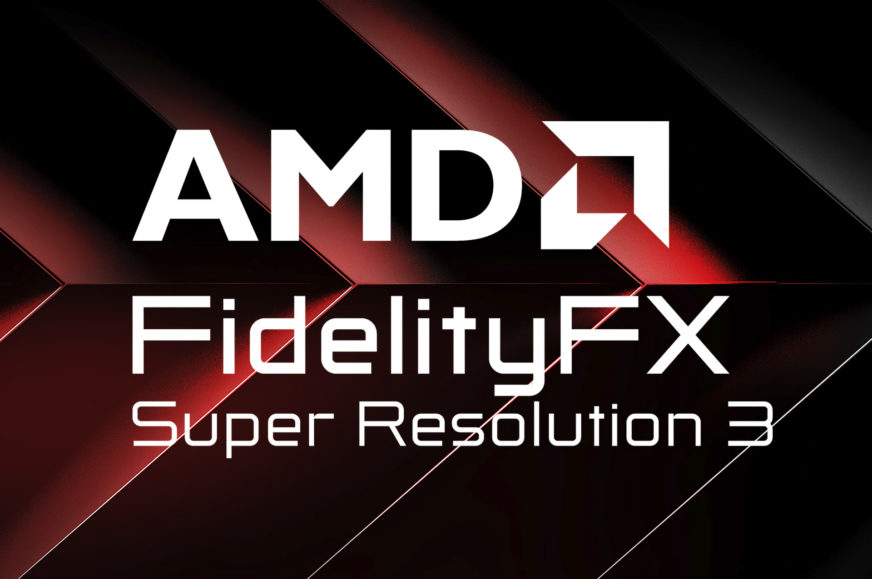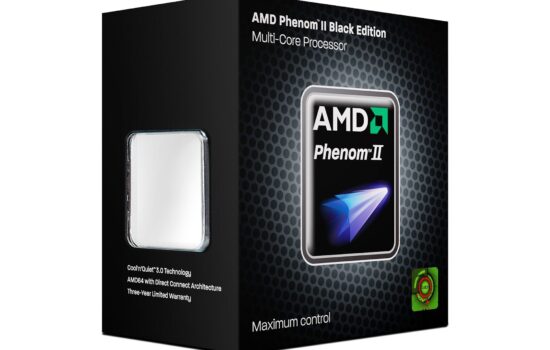FSR 3 is coming soon, first games in a month
Last week at Gamescom, AMD added two new SKUs to its Radeon RX 7000 graphics card line-up, the RX 7700 XT and RX 7800 XT. But there were also other, more software-side news – the upcoming FSR 3 or FidelityFX Super Resolution 3 technology, featuring the so-called Fluid Motion Frames. It is an open-source alternative to Nvidia’s DLSS 3 technology that will work on a broad portfolio of GPUs, including older generations.
AMD has made a first pre-announcement of FSR 3 last year when it unveiled Radeon RX 7000 GPUs, but it’s been a long wait for the announcement of in-game availability and more details. This just arrived during last week’s Gamescom, so now we finally have more clarity on how long it will take for FSR 3 to start appearing in games, and on the first such titles.
FidelityFX Super Resolution 3 and Fluid Motion Frames
The main new feature in FSR 3 (same as in DLSS 3) is frame generation, in the sense that new frames are created on top of the set that the game itself produces. These new “generated” frames or in-between frames are created through interpolation from the frames rendered and calculated by the game. However, their generation is performed independently of the game itself. The whole concept is more or less the same as interpolating frames or increasing the frame rate of video output that is routinely performed by TVs.
The feature is called AMD Fluid Motion Frames (AFMF) and is based on the optical flow technique, which should mean that the visual data itself is analyzed to detect the movement of objects between frames and, based on this, to reconstruct the intermediate state that should be visible in the newly generated frame. In addition to the optical flow analysis, “metadata” such as motion vectors extracted from the game engine are used as well – as with FSR 2.x. Frame generation works simultaneously with these two sources of motion information.
In theory, you could generate unlimited number of artificial intermediate frames between two real/input frames this way, but FSR 3 (as well as Nvidia’s DLSS 3) currently only insert just a single generated frame. This has the advantage that the real frames are displayed half of the time, with the generated and potentially lower quality frames just flashing in between. This somewhat mitigates the visual impact of potential artifacts that could be introduced in those frames.
Interpolation (generation) of frames is said to be linked to FSR 2.x, i.e. upscaling using temporal reconstruction and motion vectors, which should make the whole process more efficient. AMD also states that the frame generation algorithm will specifically pay attention to the game’s GUI and other HUD elements that are not directly part of the scene. FSR 3 is supposed to make sure to not disturb these elements.
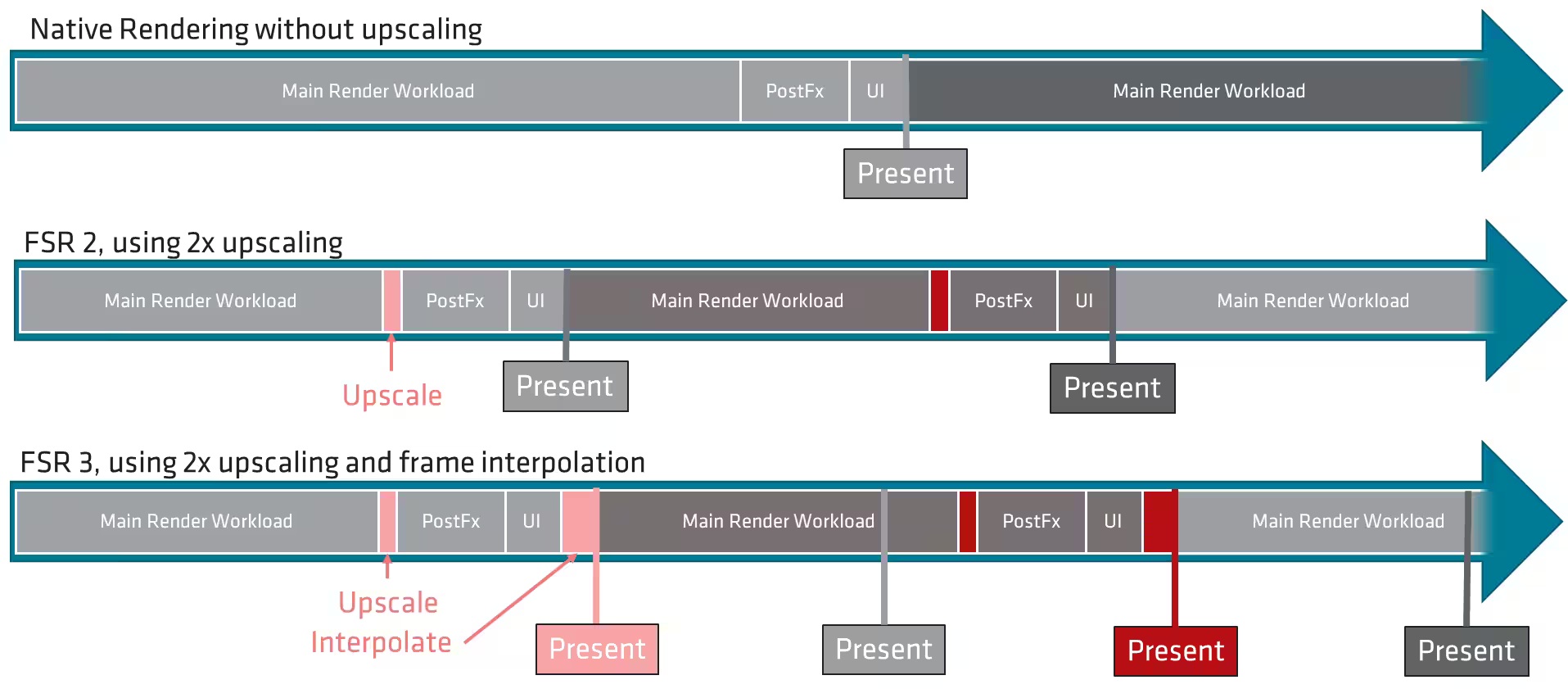
FSR 3 will run on virtually all graphics cards
According to this description, it seems that the operation of FSR 3 is very similar to the competing DLSS 3 (there is not much to invent here, this approach has already been used for many years in TVs). The difference is that Nvidia uses specialized hardware units present in Ada Lovelace generation GPUs for optical flow analysis, whereas FSR 3 is written in such a way that it only requires general purpose GPU compute units.
DLSS 3 should thus have the potential to achieve slightly better quality, as it theoretically has more performance available for its calculations. FSR will probably have a more limited “computational budget”. It may also have a bit more overhead, so the increase in output FPS may be a bit smaller – it will probably often stop short of achieving exactly twice the FPS, only yielding a bit smaller uplift.
On the other hand, by using only standard shader units, FSR 3 is not limited to select GPU architectures (and vendors). Neither specific AI accelerators nor motion vector search/optical flow accelerators are used. Instead, the code is fully written in HLSL for shader units. AMD has already confirmed that FSR 3 and its frame generation will work on many different platforms including gaming consoles. Officially, the technology is supported on Radeon RX 5700 and newer cards (RX 6000 and 7000 generation cards recommended), and on Nvidia’s GeForce RTX 2000 and newer (RTX 3000 recommended).
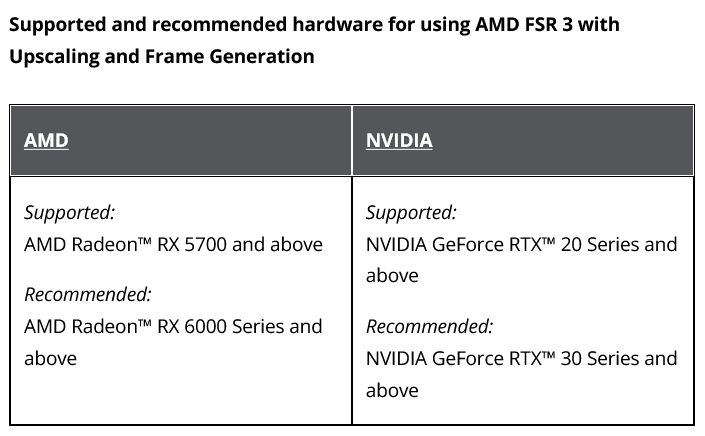
But this is not a hard limitation, and you can run FSR 3 on older graphics cards too, but everything will be slower in that case. The only real criteria is that the GPU must have enough power for the game itself and for running the algorithms that generate the extra frames to make it useful in practice. So while there’s nothing from Intel in the table of supported GPUs, Arc graphics cards will certainly work with FSR 3 as well.
Open source technology
Like FSR 1.0 and FSR 2.x, this technology will be open source, including the code which can be studied and improved by anyone. This is naturally true for the competition as well – the downside for AMD is that the company can’t keep any special tricks secret, and Nvidia and/or Intel will always be able to copy them into their alternative products, which aren’t open source. The code will be published in the FidelityFX SDK and on the GPUOpen website.
Worse latency
The disadvantages are the same as with DLSS 3 – the generated frames do not respond to player input and don’t correspond to the game’s physics and AI calculations. They are generated purely from the final image – i.e. the pixels of the frame plus the motion detected between frames by “optical flow” analysis and learned from the motion vectors.
The generated frames can give the impression of greater fluidity, especially when the image is moving slowly and smoothly, but they may approximate motion incorrectly when the scene is moving irregularly and quickly (or for example when the screen “shakes”, for example). So it’s not entirely correct to talk about these techniques improving the smoothness of games and “increasing FPS”, that’s only true under certain conditions. It could rather be said that these technologies create a more or less successful illusion of fluidity and higher FPS.
A major complication is that to interpolate an intermediate frame, you first need to have the previous frame and the following one available. So when using FSR 3 or DLSS 3, the game must buffer one extra frame before displaying, which increases the latency (input lag) of the game. This is inherent to the technology and always happens. Nvidia has tried to claim the opposite, i.e. that DLSS 3 improves latency, which was however based on minxing-in Reflex technology into DLSS3. But this is downright misleading, because Reflex technology is unrelated and can and indeed was used separately without DLSS 3 (and you hadve to use it without DLSS 3 to truly minimize latency). What happens with generated frames is that this improvement achieved by Reflex is sacrificed to compensate for the latency degradation introduced by DLSS 3. If frame interpolation is added on top of Reflex, the overall latency always goes up.
Linking with Anti-Lag and the new Anti-Lag+
AMD has developed similar latency reduction technology (before Reflex, even, for purposes of competitive gaming) called AMD Anti-Lag, and it will be paired with FSR 3 to mitigate the impact of latency degradation. With Radeon RX 7000 generation graphics cards, latency reduction effect is to be further improved with the new and improved Anti-Lag+ technology, which is supposed to be specifically tailored to further reduce the impact when using FSR 3.
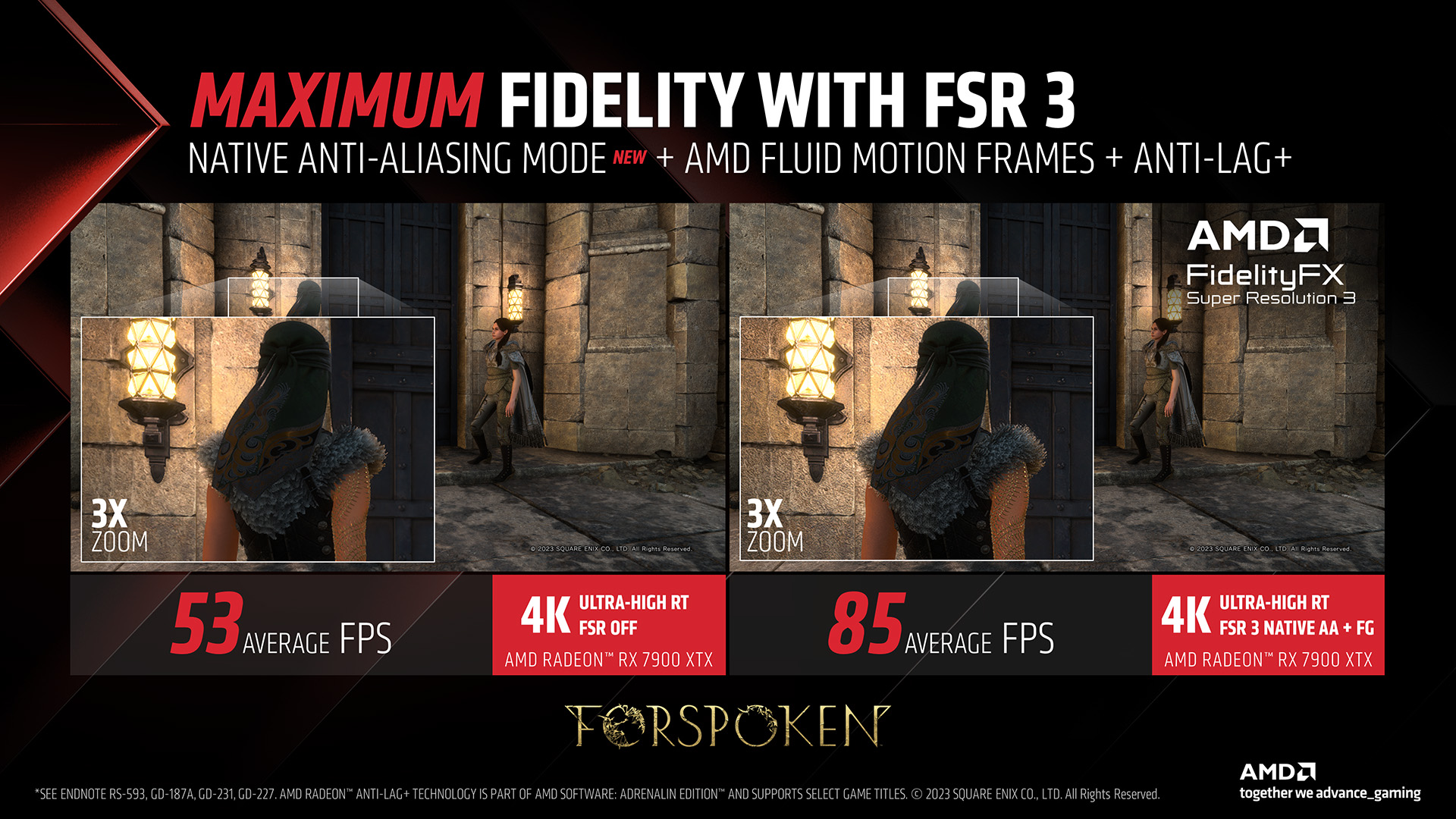
Generally, because of latency, it is recommended to use frame generation only when the game is already running around 60 FPS without it – which gets you somewhere in the 100–120 FPS range. In this situation, the impact on latency (and possible unnaturalness of motion) won’t matter as much.
Help for games limited by CPU performance
It was mentioned that the generated frames are created independently of the game’s engine’s computations. This has one major consequence – DLSS 3 or FSR 3 can create them even in a situation where the game engine is limited by CPU performance and would not be able to prepare any more frames for the GPU. In such a situation, DLSS 2.x or FSR 2.x won’t help you anymore, because they only lighten the load on the GPU, but the work for the CPU remains the same. Thus some games still have poor performance even at low resolutions precisely because the CPU can’t keep up with geometry calculations, enemy AI calculations and so on.
When using DLSS 3 or now FSR 3, this problem is bypassed and the graphics cards will basically automatically double the output frame rate (albeit with the caveats mentioned a moment ago). An example of such a game is the current Microsoft Flight Simulator, where it was practically impossible to get good FPS because of the huge CPU performance requirement, you only get higher frame rates by using frame generation.
Doubling the frame rate using the generated frames can also be achieved in situations where limitations exist on the GPU side, i.e. at high resolutions like 4K, 5K, 8K. But in this scenario it is probably better to rely for FSR 2.x and DLSS 2.x first and only then generate frames if those don’t suffice.
First tasting in a month?
That said, what we described is the theory behind the involved techniques. How well will FSR 3 work in practice will only be determined once the finished games that incorporate the technology arrive for testing. This is especially true of the visual impact interpolation will have.

The first game announced with support for FSR 3 and Fluid Motion Frames will be Square Enix’s Forspoken, followed by Immortals of Aveum from Ascendant Studios / EA. Patches with FSR 3 support are expected to be released in September or early autumn for these games. After these two, ten more games are currently known to get FSR 3 at some later point, including Cyberpunk 2077. AMD says it’s working with 15 game studios on in-game support now, with more expected to come.






